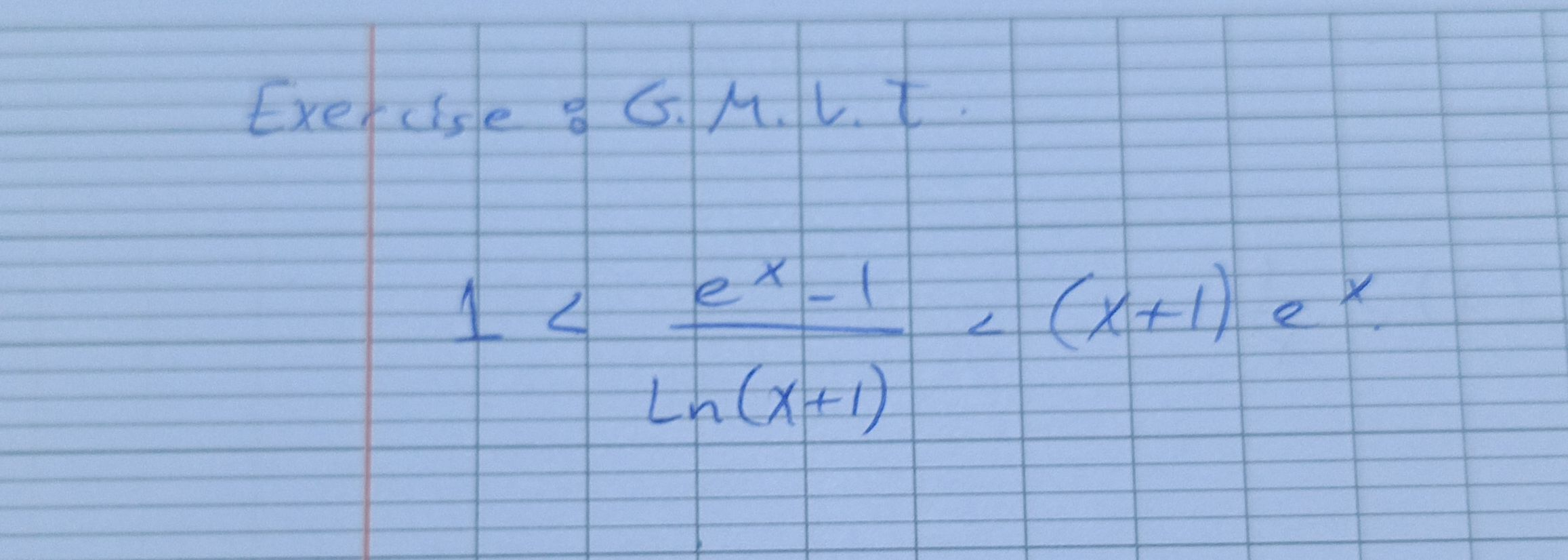Full solution
Q. Exercise: G.M.L.T.
- Define Domain: First, we need to address the domain of the function to avoid any undefined expressions. The natural logarithm is defined for x > -1. Additionally, since we have an inequality involving a fraction, we must ensure that the denominator is not zero, so cannot be equal to . Thus, the domain of is x > -1 and .
- Solve Left Inequality: Next, we will solve the left part of the inequality: 1 < \frac{e^{x}-1}{\ln(x+1)}. We will multiply both sides by to get rid of the denominator, but we must remember that the direction of the inequality will depend on the sign of . Since is positive for x > 0 and negative for -1 < x < 0, we will have to consider these two cases separately.
- Consider Cases: For x > 0, is positive. Multiplying both sides of the inequality by gives us \ln(x+1) < e^{x}-1. We then add to both sides to isolate on one side: \ln(x+1) + 1 < e^{x}.
- Solve Right Inequality: For -1 < x < 0, is negative. Multiplying both sides of the inequality by and reversing the inequality sign gives us \ln(x+1) > e^{x}-1. We then add to both sides to isolate on one side: \ln(x+1) + 1 > e^{x}. However, this case leads to a contradiction since is always greater than for -1 < x < 0. Therefore, there are no solutions in this interval.
- Simplify Inequality: Now we will solve the right part of the inequality: (e^{x}-1)/(\ln(x+1)) < (x+1)e^{x}. We will multiply both sides by to get rid of the denominator. Since we are considering x > 0, is positive, and the direction of the inequality remains the same: e^{x}-1 < (x+1)e^{x}\ln(x+1).
- Isolate Term: We simplify the inequality by distributing on the right side: e^{x}-1 < e^{x}(x+1)\ln(x+1) - e^{x}\ln(x+1). This simplifies to -1 < e^{x}x\ln(x+1) - e^{x}\ln(x+1).
- Factor Out: We can then add to both sides to isolate the term with on one side: e^{x}\ln(x+1) - 1 < e^{x}x\ln(x+1).
- Divide and Solve: Now we can factor out on the right side: e^{x}\ln(x+1) - 1 < e^{x}\ln(x+1)(x).
- Complex Inequality: We divide both sides by to solve for . Since is positive for x > 0, the direction of the inequality remains the same: \frac{1}{e^{x}\ln(x+1)} - \frac{1}{(e^{x}\ln(x+1))^2} < x.
- Summary: This inequality is quite complex to solve algebraically, and it may require numerical methods or graphing techniques to find the exact range of that satisfies it. However, we can see that as increases, the left side approaches , and thus for sufficiently large , the inequality will be satisfied.
- Summary: This inequality is quite complex to solve algebraically, and it may require numerical methods or graphing techniques to find the exact range of that satisfies it. However, we can see that as increases, the left side approaches , and thus for sufficiently large , the inequality will be satisfied.To summarize, we have found that for x > 0, the inequality \ln(x+1) + 1 < e^{x} must be satisfied, and for sufficiently large , the inequality \frac{1}{e^{x}\ln(x+1)} - \frac{1}{(e^{x}\ln(x+1))^2} < x is satisfied. Therefore, the range of that satisfies the original inequality is a subset of x > 0, excluding any values that do not satisfy both parts of the inequality.
More problems from Solve advanced linear inequalities
QuestionGet tutor help

